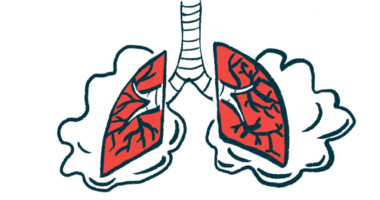LEMS often goes unrecognized in US patients with lung cancer: Study
Standard LEMS screening 'may be warranted' for small cell lung cancer patients

Lambert-Eaton myasthenic syndrome (LEMS) may be underdiagnosed in a sizeable fraction of people with small cell lung cancer (SCLC), a study analyzing real-world data suggests.
Based on these findings, scientists argue that standardized protocols to screen people with SCLC for LEMS “may be warranted.”
David Morrell, senior vice president of marketing at Catalyst Pharmaceuticals, will present the findings next month at the IASLC 2023 World Conference of Lung Cancer, in a poster, titled “Lambert-Eaton Myasthenic Syndrome is Underrecognized in Small Cell Lung Cancer: An Analysis of Real-World Data.”
“Our hope is that this study will contribute to heightened awareness, leading to early diagnoses and ultimately improving the quality of life for those affected by LEMS and small cell lung cancer,” Patrick McEnany, Catalyst’s chairman and CEO, said in a company press release. Catalyst is the company that markets the approved LEMS therapy Firdapse (amifampridine).
Many cases of LEMS occur in people who have cancer, particularly SCLC
LEMS is an autoimmune disorder that causes symptoms like muscle weakness, fatigue, and lack of reflexes. While the disorder can develop in the absence of an underlying illness, many cases of LEMS occur in people who have cancer, particularly SCLC, an aggressive type of lung cancer. Current estimates suggest that about 3% of people with SCLC also have LEMS.
“Because some non-specific LEMS symptoms may be attributed to SCLC or its treatment, comorbid LEMS may go unrecognized,” the researchers wrote.
In this study, researchers analyzed U.S. insurance databases to determine the frequency of LEMS among people with SCLC.
They found that, out of 46,996 SCLC patients included in the analysis, 77 or 0.16% had insurance claims suggesting a diagnosis of LEMS. That’s about a tenth of the current estimated prevalence of 3%, which suggests that many people with LEMS may not be correctly diagnosed.
“The results from the study have brought to light significant insights into the relationship between small-cell lung cancer and Lambert Eaton myasthenic syndrome,” McEnany said.
The study “adds to the growing body of evidence illustrating that the prevalence of LEMS, including individuals with small cell lung cancer, is now estimated to be about 3,600 to 5,400 people in the United States, of which a substantial number currently remain undiagnosed and untreated,” he said.
LEMS and lung cancer diagnosed around same time in 76 patients in study
Among 76 LEMS patients who had at least a year’s worth of data available, LEMS and SCLC were usually diagnosed at around the same time. LEMS was diagnosed before SCLC in 14% of cases, and more than a year after its diagnosis in 12% of the cases.
The researchers speculate that SCLC patients and clinicians might mistakenly attribute LEMS symptoms to the underlying cancer, or to side effects from cancer treatment, resulting in its underdiagnosis.
“LEMS is usually diagnosed with or after SCLC, when disease symptoms and side effects of therapy … may act as confounders,” the team wrote.
Since LEMS needs to be recognized to be treated appropriately, the team suggested that screening programs for LEMS in people with known SCLC may be useful to help ensure patients receive the best possible care.








